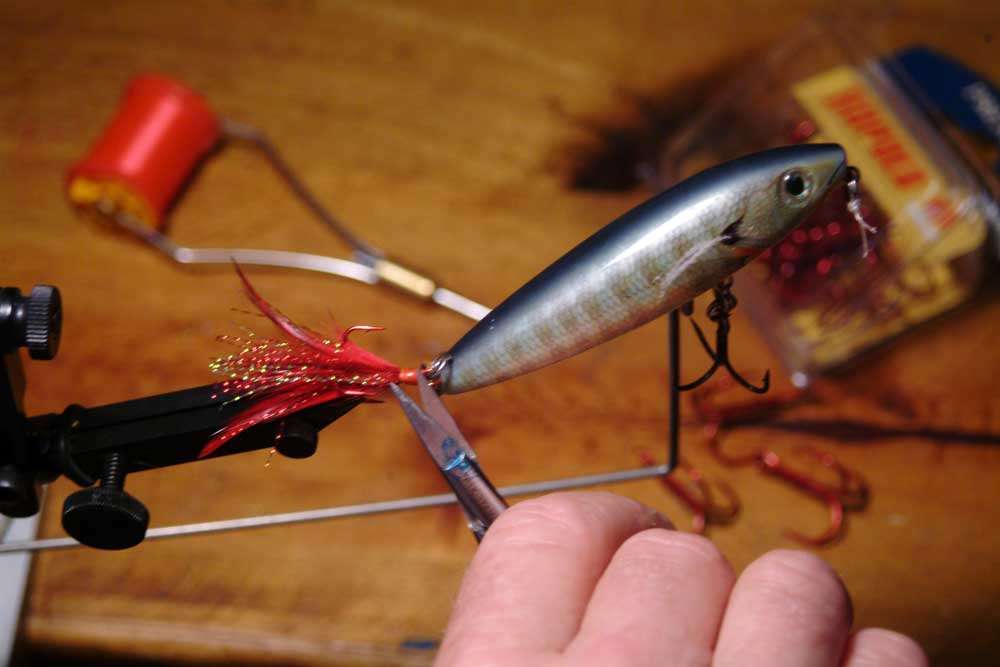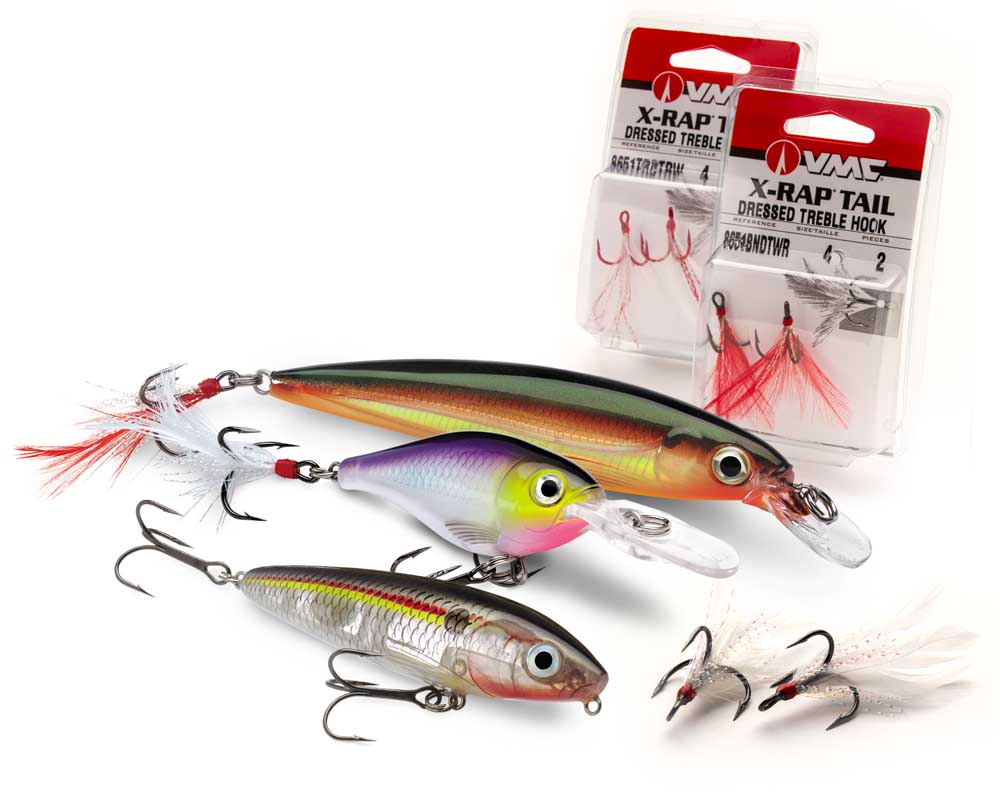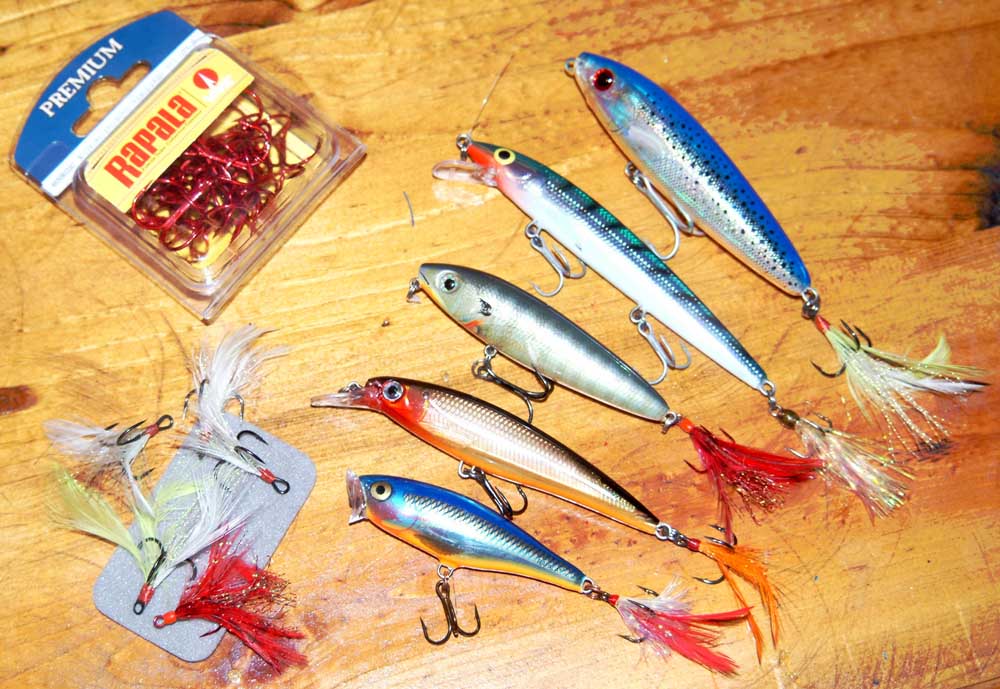
No matter how seductive a lure may look in the water, it’s not always going to fool fish. That’s a simple fact, regardless of brand or who’s doing the casting. Even worse, we often witness the refusal.
Largemouth, smallmouth, spotted bass … they all do it. They’ll follow our lures — all hot and bothered — but for inexplicable reasons, refuse to take the bait. It’s aggravating, especially on tournament day.
If you’ve experienced this problem — and I know you have — here’s a tip that can help convert some of those followers into caught fish…and it’s as easy as changing a hook!
By adding a dressed treble hook to your favorite topwater, jerkbait or even crankbait, you can give these lures a more attractive and appealing look — an added teaser, so to speak.
Some manufacturers recognize this, offering certain lures with dressed tail trebles. Hook companies, too, sell packaged treble hooks dressed with various materials, like feathers, bucktail and Mylar.
While some are good, too often selection is limited or the amount of material used is disproportionate to the hook or lure. In order for a tail-hook teaser to work effectively, the material needs to “breathe” as the lure moves.
That’s why feathers are my top choice. They have the ability to expand and contract, which translates to added movement … even when the lure is paused.
By applying the right size, texture and number of feathers to the tail hook, a lure can take on a completely different look — one that can increase your odds at making reluctant fish strike!
Feathers with Flair
The best formula is two to three sparse feathers which are proportionate to the lure — usually twice to three times the length of the hook shank. For instance, if you’re using a No.6 treble, which is approximately 3/4-inch in length, then the feather should be 1 1/2 to 2 inches long.
Larger lures obviously require larger hooks and thus can handle longer, fuller feathers. Conversely, smaller lures will need lighter, thinner feathers.

Regardless of hook size, the feathers should be soft and supple. The idea is to have them expand and contract as the lure moves through the water, without hindering its action.
Knowledgeable tiers prefer the saddle-hackle feathers of hybrid chickens — birds bred specifically for the quality of their plumage. These come in a wide range of colors and can be clipped to a desired length.
Another popular material is Mylar — a synthetic that comes in a spectrum of brilliant, highly reflective finishes. When using Mylar alone or as an accent to feathers, don’t overdo it. Use only enough material to get the reflective quality you’re after without hindering the action of the lure. As with feathers, the material should be approximately two to three times the length of the hook shank.
Both saddle-hackle feathers and Mylar are available through fly shops or online tackle dealers. And these same vendors will usually carry a selection of pre-dressed trebles as well.
But if you’re like me, you’ll want to tie some of your own.
Fit to be Tied
You don’t have to be an accomplished fly tier with a fancy vise to whip up a few dressed trebles. With a little thread or light mono, fast-drying cement, various sized hooks and material, you can create all the treble hook teasers you need.

Most seasoned anglers rely on the traditional white feathers wrapped with red thread, but I suggest you experiment. And don’t be afraid to mix colors. While the more popular combinations like white-red and white-chartreuse are visually striking, they’re only a sampling of the possibilities. I carry a number of variations, including red, yellow, orange, lime and chartreuse. That way I can compliment a wider range of lure patterns with matching or contrasting feathers.
Thread colors are also limitless. The newer reflective threads (similar to Mylar) come in a range of bright, iridescent colors.
Have fun and make your own personalized treble hook teasers, and apply them to your favorite topwaters, jerkbaits, or even crankbaits. Just about any lure possessing a strong, deliberate swimming action can handle a tail-hook teaser.
So don’t be shy. Dress your lures for success, and watch as those following fish become fighting fish on the end of your line.
Follow Bernie Schultz on Facebook or though his website.





